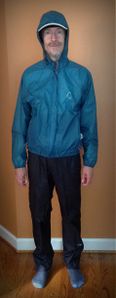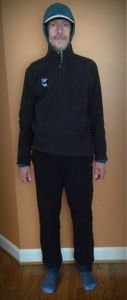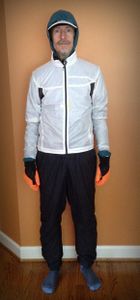Heat Acclimation Training

Heat acclimation training can improve performance in hot and cold conditions. It also helps protect against heat injury and is particularly important when training for spring races. However, heat adaptation training can be dangerous and care must be taken to avoid injury or death.
Contents
1 Introduction
Training for a spring race requires extra caution as you will have been training through the winter and be unprepared for warm conditions. While a spring race may be cool, there is also a risk of conditions that are warm enough (above 40f) to impair performance (see [Impact of Heat on Marathon Performance] for more details). Heat acclimation training, sometimes called heat adaptation training, can prepare you for these warmer conditions. This type of training is also valuable if you are traveling to a warmer climate for a race, or if you are training in the cool part of the day for a race in the warmer times. In addition, heat acclimation can improve cold weather performance. One study[1] showed that heat acclimation improved performance in the cold by 6% and by 8% in heat.
2 Background
Exercise becomes harder as the temperature rises, with 40 degrees Fahrenheit being close to optimal. Exercise in the heat causes blood vessels in the skin to expand to help with cooling. The demands of the extra blood for cooling creates added stress on the cardiovascular system[2]. The athlete's body will also sweat to produce cooling; in dry conditions evaporation of sweat provides 98% of cooling and in humid conditions 80%[2]. The loss of fluids due to sweating can lead to dehydration that also impairs performance. The impact of dehydration is in addition to the impact of the heat[2].
3 Danger of Death
A dedicated athlete can push themselves hard enough to raise their core temperature to dangerous levels, leading to heatstroke, which can be fatal[3]. Heatstroke can be the result of prolonged exercise in hot conditions, but it can also be the result of shorter periods of high intensity exercise, especially in the untrained or overweight. It is vitally important that heat acclimation training is started gradually. You must become aware of how your body is adjusting to the heat, and to learn the warning signs of elevated core temperatures. Training in heat suits (see below) is especially dangerous, as the heat will not escape even after you collapse! Generally, an athlete reaches 'voluntary exhaustion' when their core temperature reaches about 39c/102f[4], so never push hard with heat acclimation. I would take it as a personal favor if you could avoid killing yourself.
4 Symptoms of Heat Stroke
If you have any of the following symptoms while performing heat acclimation training, you should stop and cool off. Taking your internal temperature, ideally with an in-ear thermometer will allow you to double check if this is heat stroke. Heat stroke is caused by an internal temperature of >40.6 °C (105.1 °F), is extremely dangerous and can be fatal. The following can be symptoms of heat stroke:
- Nausea or vomiting. These symptoms can occur before true heatstroke, as running makes digestion harder.
- Weakness. An unusual muscular weakness could be due to low blood sugar, but elevated core temperature also creates weakness.
- Headache. This can also be caused by dehydration, or low blood sugar. Having had headaches from each of the three causes, I have found the type of headache is different. My limited experience is that a headache caused by heat is particularly painful and intense.
- Dizziness or confusion. This is a serious symptom that suggests either extremely low blood sugar or heatstroke.
- Panting. My personal experience is that when my core temperature rises, I start to breathe more rapidly. The panting can occur at rest in a sauna, or during exercise where my breathing rate is far deeper and faster than would be typical for the exercise intensity. This panting may be a reflect that attempts to cool the body in the same way as a panting dog. I find this is the first warning of problems and a sign that I have to reduce the heat stress rapidly.
If you have any doubts, stop and check your temperature. Never do High Intensity Interval Training as part of heat acclimation; the intense work can spike your core temperature too high too quickly for you to recover.
5 Practical Heat Training
The following advice should be used as guidance for heat acclimation training. Please use caution and common sense.
- Like any new training routine, start off slowly and build up both duration and intensity over time.
- Be aware of how you are feeling and avoid pushing hard.
- Build up to exercising at 50% VO2max or above[5]. 50% of VO2max is about 70% of maximum Heart Rate[6] or "very slow running"[7].
- Use gradually increasing periods from 30 to 100 minutes over 10 to 14 days[8]
- Acclimation is fully developed after 7 to 14 days[5], but up to 75% of acclimation is reached after 5 days [8].
- Reduce your training load to compensate for the added stress of the heat. The heat can make you far more tired than you would expect.
- Consider alternating heat acclimation training and cooler training to preserve intensity[9]
- Training in a warmer environment is ideal, but creating a microclimate (see Heat Suit below) by overdressing also works[9]
- Exercise in heat produces better acclimation than passive heat[10], but passive heat (sauna) following exercise can also be quite effective[11].
- Maintain hydration levels, as dehydration may impair key adaptations, such as increased sweat rate[12].
- Once gained, heat adaptation can be maintained for at least a month by training in the heat every five days[13]. Without continued heat exposure, it's estimated that 2.5% of adaptation is lost each day[14].
6 Fellrnr Heat Suit
This 'heat suit' will allow for heat training even in quite cool conditions.
The key to the Fellrnr Heat Suit comes from two waterproof layers. A traditional sweat suit uses a single waterproof layer to trap your sweat and preventing it from cooling your body. The problem with the single layer is that the sweat soaks through any clothing and reduces the insulation. In cooler conditions the sweat soaked clothes can become chilly even with the waterproof layer. The Fellrnr Heat Suit approach traps the sweat away from the insulation layer, preventing this cooling effect. The Fellrnr Heat Suit has the following layers over both your top and legs.
This combination will prevent the majority of heat escaping your body.
7 Steam Shower
I have a steam shower which I also use for heat acclimation, and it's wonderful. We put in the Thermasol Smart Steam system that was expensive, but well worth it. It provides rapid steam, with the initial steam after just a minute or so, and serious heat stress after about 5-10 minutes. If you turn it up, it will exceed your ability to cope quite quickly, or provide extended exposure at more moderate levels.
8 The Science of Heat Acclimation
For those who want to know more details about heat acclimation, here is a summary of the scientific data.
8.1 Changes with heat acclimation
Heat acclimation will produce a number of benefits
- Increased blood volume[15].
- Sweating occurs at lower temperatures[9].
- Sweat contains less electrolytes[16].
- Sweating is more profuse[4].
- Increased cardiac output in hot conditions[4].
- Reduced core temperature for given exercise time and intensity[4].
- The athlete becomes psychologically prepared for heat stress. [10].
- The ability to consume and absorb more fluids (anecdotal evidence only).
8.2 Notes on Heat Acclimatization
- Younger runners do better in the heat than older runners but training can negate this[5]
- Acclimation is faster in fitter athletes[5]
- On return to a cool climate, acclimation lasts for about a week, then decays[5]
- People who have always lived in hot climates are believed to have superior adaptation[9]
- A sauna will produce similar heart rate and cardiac stress as 60-100w of exercise[17]. My experience matches that estimate for heart rate, though my respiration tends to be much higher as my body attempts to pant to cool off.
9 See Also
10 references
- ↑ S. Lorenzo, JR. Halliwill, MN. Sawka, CT. Minson, Heat acclimation improves exercise performance., J Appl Physiol (1985), volume 109, issue 4, pages 1140-7, Oct 2010, doi 10.1152/japplphysiol.00495.2010, PMID 20724560
- ↑ 2.0 2.1 2.2 DJ. Casa, Exercise in the heat. I. Fundamentals of thermal physiology, performance implications, and dehydration., J Athl Train, volume 34, issue 3, pages 246-52, Jul 1999, PMID 16558572
- ↑ HM. Binkley, J. Beckett, DJ. Casa, DM. Kleiner, PE. Plummer, National Athletic Trainers' Association Position Statement: Exertional Heat Illnesses., J Athl Train, volume 37, issue 3, pages 329-343, Sep 2002, PMID 12937591
- ↑ 4.0 4.1 4.2 4.3 B. Nielsen, JR. Hales, S. Strange, NJ. Christensen, J. Warberg, B. Saltin, Human circulatory and thermoregulatory adaptations with heat acclimation and exercise in a hot, dry environment., J Physiol, volume 460, pages 467-85, Jan 1993, PMID 8487204
- ↑ 5.0 5.1 5.2 5.3 5.4 LE. Armstrong, CM. Maresh, The induction and decay of heat acclimatisation in trained athletes., Sports Med, volume 12, issue 5, pages 302-12, Nov 1991, PMID 1763248
- ↑ DP. Swain, KS. Abernathy, CS. Smith, SJ. Lee, SA. Bunn, Target heart rates for the development of cardiorespiratory fitness., Med Sci Sports Exerc, volume 26, issue 1, pages 112-6, Jan 1994, PMID 8133731
- ↑ http://www.brianmac.co.uk/vo2max.htm
- ↑ 8.0 8.1 Y. Shapiro, D. Moran, Y. Epstein, Acclimatization strategies--preparing for exercise in the heat., Int J Sports Med, volume 19 Suppl 2, pages S161-3, Jun 1998, doi 10.1055/s-2007-971986, PMID 9694427
- ↑ 9.0 9.1 9.2 9.3 Timothy Noakes, Lore of running, date 2003, publisher Human Kinetics, location Champaign, IL, isbn 0-87322-959-2, pages 188
- ↑ 10.0 10.1 Taylor, Nigel AS, and James D. Cotter. "Heat adaptation: guidelines for the optimisation of human performance: review article." International SportMed Journal: The Extreme Environment and Sports Medicine: Part 2 7.1 (2006): p-33.
- ↑ GS. Scoon, WG. Hopkins, S. Mayhew, JD. Cotter, Effect of post-exercise sauna bathing on the endurance performance of competitive male runners., J Sci Med Sport, volume 10, issue 4, pages 259-62, Aug 2007, doi 10.1016/j.jsams.2006.06.009, PMID 16877041
- ↑ Gavin Travers, David Nichols, Nathan Riding, José González-Alonso, Julien D. Périard, Heat Acclimation with Controlled Heart Rate, Medicine & Science in Sports & Exercise, 2020, pages 1, ISSN 0195-9131, doi 10.1249/MSS.0000000000002320
- ↑ J. Luke Pryor, Riana R. Pryor, Lesley W. Vandermark, Elizabeth L. Adams, Rachel M. VanScoy, Douglas J. Casa, Larry E. Armstrong, Elaine C. Lee, Lindsay J. DiStefano, Jeffrey M. Anderson, Carl M. Maresh, Intermittent exercise-heat exposures and intense physical activity sustain heat acclimation adaptations, Journal of Science and Medicine in Sport, volume 22, issue 1, 2019, pages 117–122, ISSN 14402440, doi 10.1016/j.jsams.2018.06.009
- ↑ Hein A. M. Daanen, Sebastien Racinais, Julien D. Périard, Heat Acclimation Decay and Re-Induction: A Systematic Review and Meta-Analysis, Sports Medicine, volume 48, issue 2, 2017, pages 409–430, ISSN 0112-1642, doi 10.1007/s40279-017-0808-x
- ↑ B Nielsen, J R Hales, S Strange, N J Christensen, J Warberg, B Saltin, Human circulatory and thermoregulatory adaptations with heat acclimation and exercise in a hot, dry environment., The Journal of Physiology, volume 460, issue 1, 1993, pages 467–485, ISSN 00223751, doi 10.1113/jphysiol.1993.sp019482
- ↑ Timothy Noakes, Lore of running, date 2003, publisher Human Kinetics, location Champaign, IL, isbn 0-87322-959-2, pages 214
- ↑ S. Ketelhut, R.G. Ketelhut, The blood pressure and heart rate during sauna bath correspond to cardiac responses during submaximal dynamic exercise, Complementary Therapies in Medicine, volume 44, 2019, pages 218–222, ISSN 09652299, doi 10.1016/j.ctim.2019.05.002




